Abstract
Purpose
To evaluate the effect of surface conditioning on the shear bond strength of zirconium-oxide ceramic to 4 luting agents.
Materials and methods
A total of 120 disk-shaped zirconium-oxide ceramic blocks (3Y-TZP, Kyoritsu, Japan) were treated as follows: (1) Sandblasting with 110 μ m aluminum-oxide (Al2O3) particles; (2) tribochemical silica coating (Rocatec) using 110 μ m Al2O3 particles modified by silica; (3) no treatment. Then zirconium-oxide ceramic blocks bonded with 4 luting cements (RelyX luting (3M ESPE), Maxcem (Kerr), Nexus3 (Kerr), Rely X Unicem (3M ESPE)). Each group was tested in shear bond strengths by UTM. A 1-way analysis of variance and 2-way analysis of variance was used to analyze the data (α = .05).
Results
RelyX unicem in combination tribochemical silica-coating produced a highest bond strength (P < .05). Air abrasion group and Rocatec treatment groups resulted in significantly higher than no conditioning group (P < .05). RelyX Luting groups showed lower bond strength than other groups. There were significant differences among groups (P < .05).
Go to : 
REFERENCES
1.Ozcan M., Vallittu PK. Effect of surface conditioning methods on the bond strength of luting cement to ceramics. Dent Mater. 2003. 19:725–31.
2.Phark JH., Duarte S Jr., Blatz M., Sadan A. An in vitro evaluation of the long-term resin bond to a new densely sintered high-purity zirconium-oxide ceramic surface. J Prosthet Dent. 2009. 101:29–38.

3.Palacios RP., Johnson GH., Phillips KM., Raigrodski AJ. Retention of zirconium oxide ceramic crowns with three types of cement. J Prosthet Dent. 2006. 96:104–14.

4.Ozcan M., Nijhuis H., Valandro LF. Effect of various surface conditioning methods on the adhesion of dual-cure resin cement with MDP functional monomer to zirconia after thermal aging. Dent Mater J. 2008. 27:99–104.
5.Manicone PF., Rossi Iommetti P., Raffaelli L. An overview of zirconia ceramics: basic properties and clinical applications. J Dent. 2007. 35:819–26.

6.Aboushelib MN., Matinlinna JP., Salameh Z., Ounsi H. Innovations in bonding to zirconia-based materials: Part I. Dent Mater. 2008. 24:1268–72.

7.Lu ¨thy H., Loeffel O., Hammerle CH. Effect of thermocycling on bond strength of luting cements to zirconia ceramic. Dent Mater. 2006. 22:195–200.
8.Chaiyabutr Y., McGowan S., Phillips KM., Kois JC., Giordano RA. The effect of hydrofluoric acid surface treatment and bond strength of a zirconia veneering ceramic. J Prosthet Dent. 2008. 100:194–202.

9.Bindl A., Lu ¨thy H., Mo ¨rmann WH. Thin-wall ceramic CAD/CAM crown copings: strength and fracture pattern. J Oral Rehabil. 2006. 33:520–8.

10.Ernst CP., Cohnen U., Stender E., Willershausen B. In vitro retentive strength of zirconium oxide ceramic crowns using different luting agents. J Prosthet Dent. 2005. 93:551–8.

11.Blatz MB., Chiche G., Holst S., Sadan A. Influence of surface treatment and simulated aging on bond strengths of luting agents to zirconia. Quintessence Int. 2007. 38:745–53.
12.Derand T., Molin M., Kvam K. Bond strength of composite luting cement to zirconia ceramic surfaces. Dent Mater. 2005. 21:1158–62.

13.Spohr AM., Borges GA., Ju′nior LH., Mota EG., Oshima HM. Surface modification of In-Ceram Zirconia ceramic by Nd: YAG laser, Rocatec system, or aluminum oxide sandblasting and its bond strength to a resin cement. Photomed Laser Surg. 2008. 26:203–8.
14.Kern M., Wegner SM. Bonding to zirconia ceramic: adhesion methods and their durability. Dent Mater. 1998. 14:64–71.

15.De′rand P., De′rand T. Bond strength of luting cements to zirconium oxide ceramics. Int J Prosthodont. 2000. 13:131–5.
16.de Oyagu ¨e RC., Monticelli F., Toledano M., Osorio E., Ferrari M., Osorio R. Influence of surface treatments and resin cement selection on bonding to densely-sintered zirconium-oxide ceramic. Dent Mater. 2009. 25:172–9.
17.Kumbuloglu O., Lassila LV., User A., Vallittu PK. Bonding of resin composite luting cements to zirconium oxide by two air-particle abrasion methods. Oper Dent. 2006. 31:248–55.

18.Blatz MB., Phark JH., Ozer F., Mante FK., Saleh N., Bergler M., Sadan A. In vitro comparative bond strength of contemporary self-adhesive resin cements to zirconium oxide ceramic with and without air-particle abrasion. Clin Oral Investig. 2010. 14:187–92.

19.Kosmac T., Oblak C., Jevnikar P., Funduk N., Marion L. The effect of surface grinding and sandblasting on flexural strength and reliability of Y-TZP zirconia ceramic. Dent Mater. 1999. 15:426–33.
20.Willer J., Rossbach A., Weber HP. Computer-assisted milling of dental restorations using a new CAD/CAM data acquisition system. J Prosthet Dent. 1998. 80:346–53.

21.Wolfart M., Lehmann F., Wolfart S., Kern M. Durability of the resin bond strength to zirconia ceramic after using different surface conditioning methods. Dent Mater. 2007. 23:45–50.

22.Blatz MB., Sadan A., Martin J., Lang B. In vitro evaluation of shear bond strengths of resin to densely-sintered high-purity zirconium-oxide ceramic after long-term storage and thermal cycling. J Prosthet Dent. 2004. 91:356–62.

23.Janda R., Roulet JF., Wulf M., Tiller HJ. A new adhesive technology for all-ceramics. Dent Mater. 2003. 19:567–73.

24.Blixt M., Adamczak E., Linde′n LA., Ode′n A., Arvidson K. Bonding to densely sintered alumina surfaces: effect of sandblasting and silica coating on shear bond strength of luting cements. Int J Prosthodont. 2000. 13:221–6.
25.Radovic I., Monticelli F., Goracci C., Vulicevic ZR., Ferrari M. Self-adhesive resin cements: a literature review. J Adhes Dent. 2008. 10:251–8.
Go to : 
 | Fig. 8.SEM pictures of Zirconia ceramic. A: Adhesive failure (magnification ×500), B: Mixed failure (magnification ×100), C: Cohesive failure (magnification ×100). |
 | Fig. 9.SEM pictures of Zirconia ceramic (magnification ×1,000). A: Grinding with 50 μ m disk, B: Airborne particle abrasion with 110 μ m alumina, C: Rocatec conditioning. |
Table 1.
12 groups used in this study
Table 2.
Characteri stics of resin cement used in this study
Table 3.
Shear bond strength of cements by surface treatment (MPa)
Table 4.
Results of two-way ANOVA
| Source | Type III Sum of Squares | df | Mean Square | F | Sig |
|---|---|---|---|---|---|
| Model | 4185.000 | 12 | 348.750 | 353.859 | .000 |
| Surface treatment | 475.664 | 2 | 237.832 | 241.316 | .000 |
| Cement type | 1148.800 | 3 | 382.933 | 388.544 | .000 |
| Surface treatment ∗Cement type | 229.803 | 6 | 38.301 | 38.862 | .000 |
| Error | 106.441 | 108 | 0.986 | ||
| Total | 4291.44 | 120 |




 PDF
PDF ePub
ePub Citation
Citation Print
Print


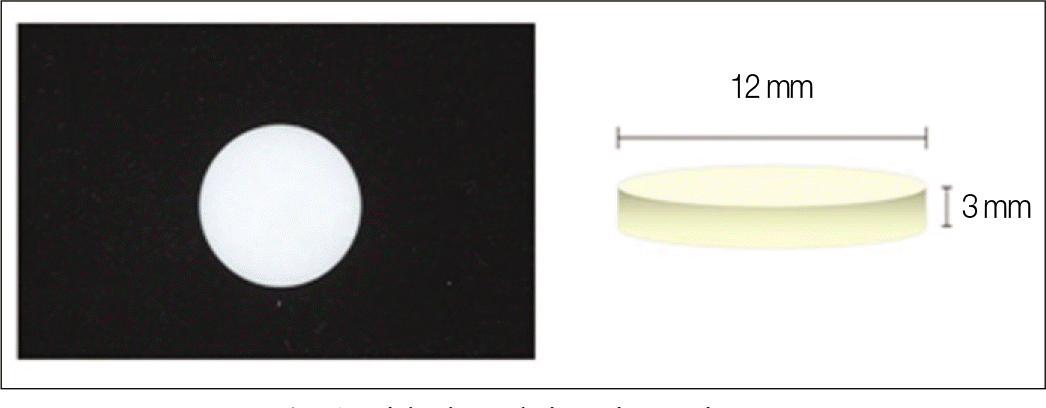
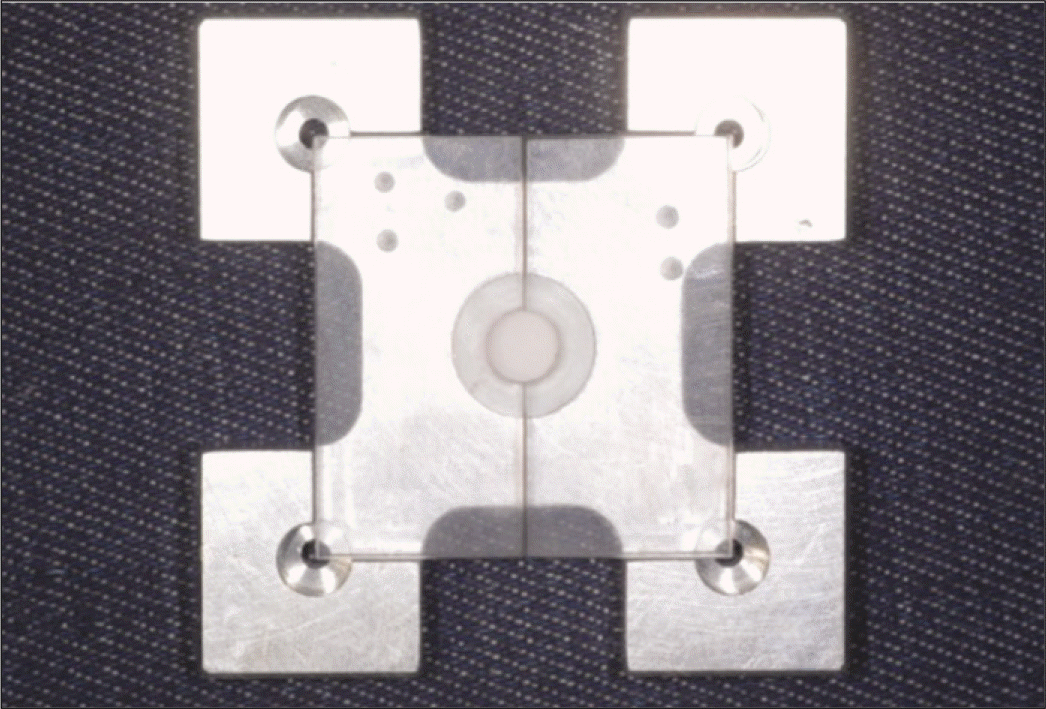
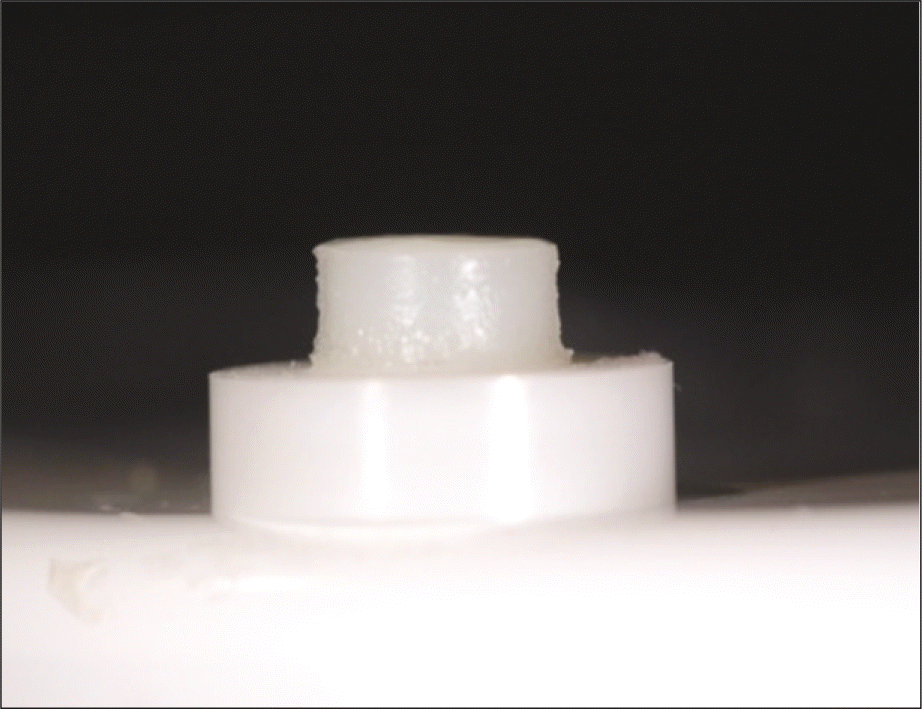
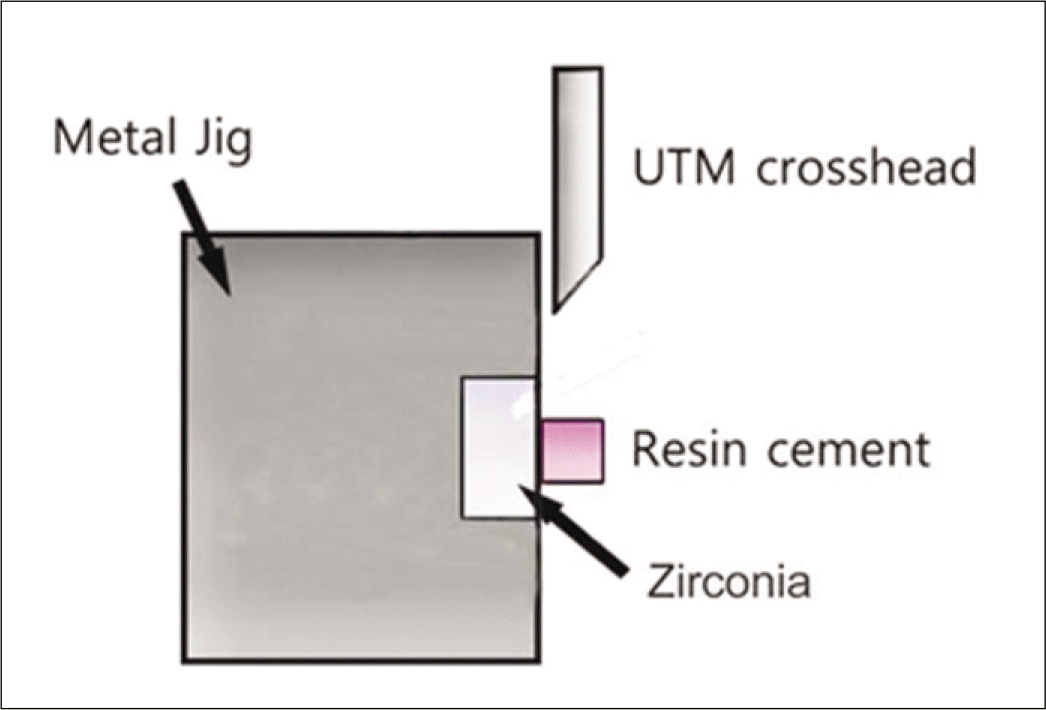
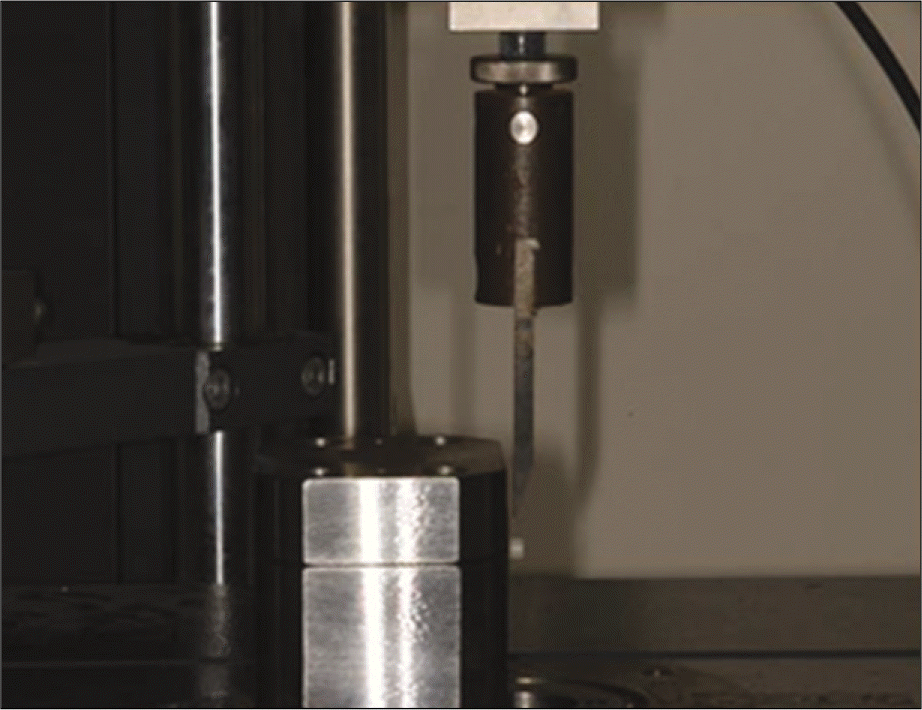
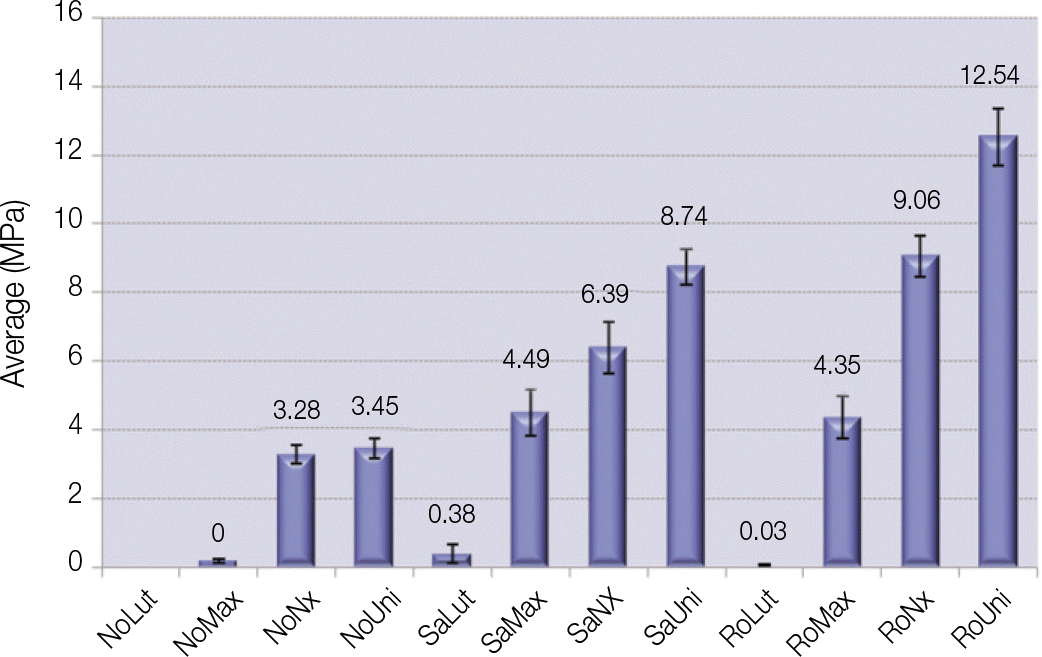

 XML Download
XML Download